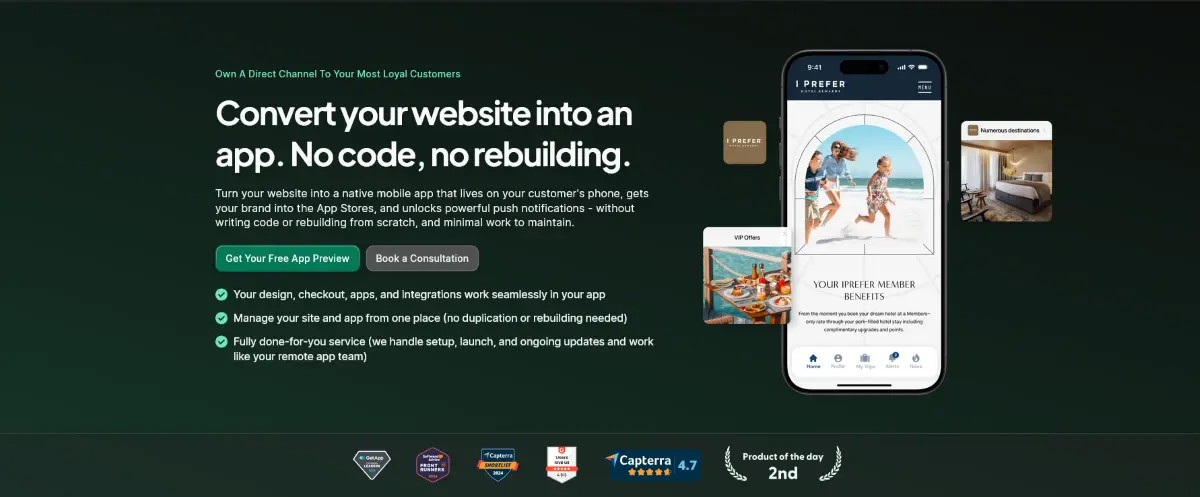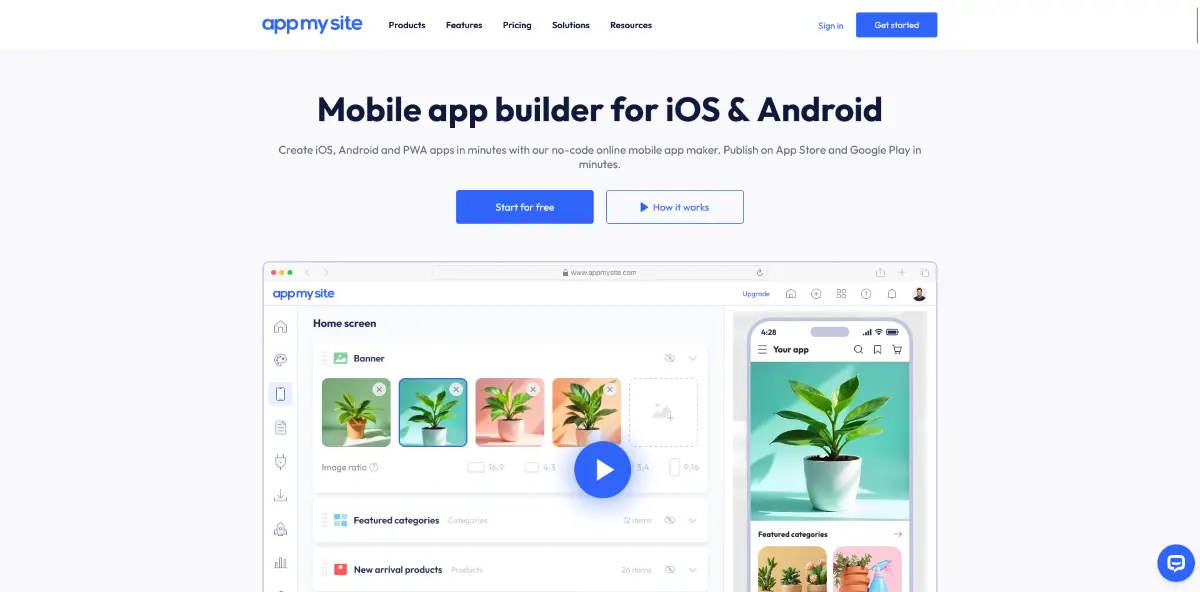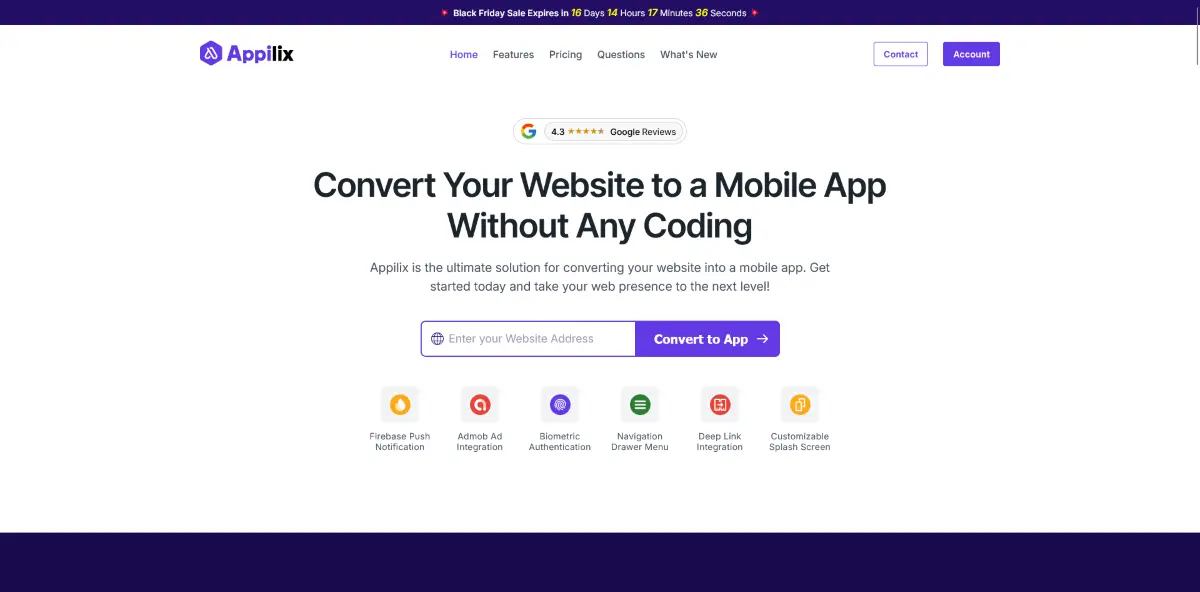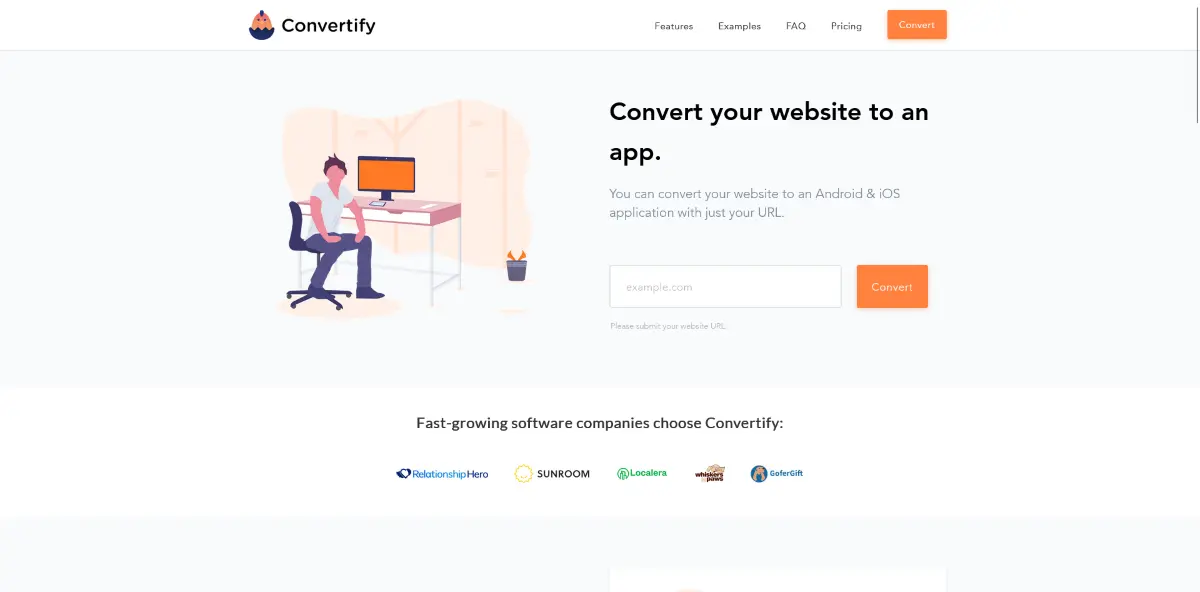The Top Website to Mobile App Converters for 2025
A lot of site owners don’t know how easy it is to launch a mobile app today.
The common expectation is that launching an app requires extensive coding, and hiring a team of developers or an expensive agency. That there’s no way a solopreneur or small business has the means to launch their own app.
The truth? If you have a website, you can have an app. Your brand, your business, in the app stores, just by converting what you’ve already built.
Choosing the right tool is key. Some are made for simple, independent sites, others for serious businesses that need an app that looks and feels like a native app.
In this guide, we’re going to break down the top website to app converters available today, compare their pros and cons, and help you choose the right way to turn your website into an app.
Table of Contents
Why Web-First Businesses Are Converting Their Sites Into Mobile Apps
Websites aren’t going away. But it’s becoming harder for retention-first online businesses to stay alive with a website alone.
It’s hard to bring people back to your website. Email’s getting harder, paid ads and cross-channel attribution is getting harder.
At the same time, more people are now mobile-first. Your customers, your users, are already on their phones.
A mobile app is just a more convenient way to interact with a business on mobile. Faster to launch, smoother to navigate. And for the business, it’s a closer connection.
The biggest reason for this trend, though, is the number of options that make it super easy to convert a website into an app.
It doesn’t cost tens or hundreds of thousands anymore. It doesn’t take expert coding ability. Just a mobile-friendly site and the right platform to turn it into a native app.
How Does a “Website to App Converter” Work?
The market is pretty broad. There are a lot of different tools and approaches out there. The high-level idea is that it should take the site you already have and allow you to launch the same thing as a mobile app.
Most of the time, it involves a webview wrapper. The webview displays a live, interactive version of your website, like a dedicated mini-browser that only shows your website.
The “wrapper”, or native “shell” is native code that runs on a mobile device, like an iPhone or Android phone. The combination of the two essentially lets your site function as a mobile app.
There are varying levels of quality. Some webview tools are very simple, displaying your website in a box and not much else. Others layer on native elements, which make your app actually look and feel like a custom mobile app.
Then other tools may work a little differently. Some are template-based, drawing your website’s content into a pre-built template. Some are more technical.
But the key feature of all? Taking what you’ve already built for the web, and turning it into an app that users can download to their phones.
The Best Website to Mobile App Converters in 2025
Ready to learn how to make your website into an app? Here are the best ways to do it.
1. MobiLoud
MobiLoud is a premium website to app converter. It’s designed for high-touch businesses like ecommerce stores, who need a high-quality, dependable mobile app made from their website.
It works for any website, built on any platform or tech stack. All your site’s features work inside of the app, and MobiLoud’s approach adds native features like navigation UI and push notifications, making it feel like a real native app.
The biggest reason MobiLoud is the best website to app converter for serious businesses is their service. It’s a fully-managed service, not just a software or a plugin. The MobiLoud team does everything, including setup, build, app store publishing and ongoing maintenance.
Key Features
- Converts any website or web app into full iOS and Android apps
- Native navigation, tabs, menus, and mobile UI enhancements
- Push notifications (integrated with OneSignal/Klaviyo)
- All website features work seamlessly inside the app
- Hands-on publishing, updates, and maintenance
| Pros | Cons |
| Native-quality UX | Higher price point than other tools |
| Fully managed from start to finish | Overkill for hobby projects or ultra-simple sites |
| Works with complex websites | |
| Reliable long-term upkeep |
Best For: Serious businesses that want a polished, reliable, native-feeling mobile app, with a dedicated team to support.
2. AppMySite
AppMySite is an affordable DIY app builder aimed mainly at WordPress and WooCommerce websites.
For WordPress, they take a template approach, rather than the wrapper angle. Your website content fills pre-built templates, made for mobile. For sites on other platforms, it works the same way as most other tools, loading a webview of your site within the app.
It’s simple enough for non-technical users and offers a quick way to launch basic iOS and Android apps.
Key Features
- Prebuilt templates for WordPress, WooCommerce, and simple content sites
- Automatic syncing of products, posts, and pages
- Basic push notifications
- Simple customization options for colors, branding, and layout
- Automated app builds for iOS and Android
| Pros | Cons |
| Very budget-friendly | Limited customization |
| Beginner-friendly, no coding required | Not ideal for custom sites |
| Quick to launch basic apps | Apps typically feel less polished |
Best For: Small WordPress or WooCommerce sites that want a low-cost, straightforward app builder with simple features and quick setup.
3. Appilix
Appilix is one of the simplest and most affordable website-to-app converters on the market. The focus is on speed and low cost rather than deep functionality, with a basic webview wrapper that turns your site into an Android and iOS app with minimal setup.
As a simple tool, it’s also affordable. You can launch your app for a one-time payment of a little over $100. That makes it popular with small businesses and hobby projects, who don’t want to invest a ton in their app.
Key Features
- Straightforward webview conversion for any website
- Basic push notification support
- Simple configuration through an online dashboard
- One-time payment plans available
| Pros | Cons |
| Very low cost | Limited customization and native features |
| Fast setup and app generation | Minimal support |
| No recurring cost required | Apps may feel generic/stripped down |
Best For: Individuals or very small businesses on a tight budget who need the simplest possible webview app with minimal features.
4. Convertify
Convertify is a very fast, lightweight service for turning any website into a basic mobile app. The focus is on simplicity and speed: you provide your URL, and they generate an Android or iOS app with minimal configuration.
It’s another no-frills approach that suits simple websites. It doesn’t offer a lot more if you’re after a higher level of customization, or any kind of service (as you’d expect for a low one-time cost).
Key Features
- Instant conversion of any website into an app
- Basic push notifications
- Simple splash screen and icon setup
- One-time payment options for Android, iOS, or both
| Pros | Cons |
| Very quick turnaround | Limited feature set and customization |
| Affordable one-time pricing | Apps may feel very bare-bones |
| Easy for non-technical users | Not ideal for businesses or complex sites |
Best For: Small, simple websites that just need a basic app quickly and cheaply without customization or ongoing support.
5. WebViewGold
WebViewGold is a popular WebView app template sold through CodeCanyon, offering a starting point for developers who want to convert a website into an app with some native elements.
It’s not a hosted platform or service. Instead, you download the source code and customize it yourself in Xcode or Android Studio.
This approach makes it more complicated than simple website to app converters. But it also makes it more customizable (if you have some coding ability).
Key Features
- iOS and Android app templates built around a WebView
- Basic native features like splash screens, pull-to-refresh, and file uploads
- Offline fallback screens
- One-time purchase with downloadable source code
- Full access to the project for developer customization
| Pros | Cons |
| Very affordable one-time cost | Requires knowledge of Xcode/Android Studio |
| Full control over code | No ongoing support or managed updates |
| Good option for developers who want to DIY a wrapper | Lacks advanced features unless manually implemented |
Best For: Developers or technical site owners who want a low-cost, modifiable codebase to build their own WebView app.
6. Progressive Web Apps (PWA)
This option is a little different. It’s not a platform or a service, but a kind of halfway step between a website and an app that any web developer can build themselves.
Progressive Web Apps aren’t native apps. They’re intended to feel like a native app, but run through the browser (like a web app).
If you just want to provide a better mobile UX, and don’t want to bother with a separate platform, promoting your app, submitting it to the app stores, a PWA can be a decent option. But it’s not a full replacement for a true mobile app.
Key Features
- Add-to-home-screen installation
- Faster caching and improved mobile performance
- Offline functionality for certain pages
- Works across all modern browsers
- Low setup and maintenance overhead
| Pros | Cons |
| Inexpensive compared to native apps | Not listed in the App Store or Play Store |
| No App Store approvals or native builds | Limited push notification support on iOS |
| Great performance improvements for mobile web | Doesn’t fully replace a real native app experience |
| Low install rate compared to true native apps |
Best For: Sites wanting a lightweight way to improve mobile UX without committing to full native apps or distributing through app stores.
7. Custom Native Development
Finally, if you have the resources or the technical expertise, you can think about doing a full, native, website to app conversion.
You (or your development team) will build a custom app UI, plus APIs to connect and share data between your website and app.
There are a ton of ways you could do this; with fully native code (Swift/Kotlin), cross-platform (React Native/Flutter), or a DIY version of the webview tools above.
If you go the custom route, you’ll obviously have more control over the app, and could end up with a better end product. But it’s only an option if you have the time and money to spend on a massive technical project.
Key Features
- Fully custom UI and UX
- Unlimited flexibility for features and integrations
- Native performance and platform-specific optimizations
- Direct access to device hardware and APIs
| Pros | Cons |
| Total control over look, feel, and functionality | Very high cost |
| Can support unique use cases that templates or wrappers can’t | Requires complicated ongoing updates |
| Strong performance and long-term extensibility | Long development timeline |
Best For: Large companies with the budget, team, and timeline to build and maintain fully custom apps.
How to Choose the Right Website to App Converter
We’ve looked at seven options to convert your website into a mobile app – five platforms, two DIY methods.
So what’s the best option?
The right choice ultimately depends on what you want, and what you have to work with. Here are the main things to consider:
- Your Budget
Website to app converters can be ultra-cheap, one-time payments. Or they can be premium, fully-managed services with a monthly subscription.
Starting with an idea of what you want to pay will instantly narrow down the options. Just consider the classic saying – “you get what you pay for”.
- The Complexity of Your Website
The simpler your site, the more basic the features, the simpler the tool you need.
A simple blog or brochure site can use almost any converter. But dynamic sites like ecommerce stores, web apps, membership platforms, and heavily customized builds will probably need something more advanced.
- Template vs Webview
Do you want a template-based app builder, or a tool that loads your existing site inside of the app?
Template-based builders are generally easier for customizing the app, separately from the website. But if you’re already happy with how your website works, a webview approach is typically the way to go.
- Ongoing Maintenance
Consider how much work you want to spend maintaining your app.
It’s rarely as simple as launching and never touching the app again. You’ll usually need regular updates, fixes, and there may be new features to add.
One-time payments mean doing all these changes yourself. A subscription service, while more expensive, may actually end up cheaper if it means you don’t need to spend time on maintenance.
- Support and Long-Term Stability
If you’re launching a serious app, made to drive revenue, you’ve got to think about the long-term picture.
A cheap tool sounds great, but you can’t expect a lot of help from the platform if you’re paying $100 one time. That means you risk losing everything if your app breaks, or if it gets delisted from the app stores.
- Timeline to Launch
If speed matters, some converters can generate an app in a couple of days. Custom development or heavily templated rebuilds can take weeks or months.
Choosing the right platform is about finding the balance between cost, effort, customization, and what kind of app experience you want to deliver.
Conclusion
Mobile apps have never been more accessible. Today, you can convert a website to an app in a number of different ways.
Micro teams or solo site owners can create an app from as little as $100, one-time, no recurring cost. While businesses with a little more to invest can launch high-quality mobile apps, supported by a dedicated team.
The takeaway? Resources are no excuse for not having your own app anymore. And with mobile still on the rise, and attention getting harder to hold on to, the smart move for any online business is to be available on the app stores.





